 |
||
|
Mystical Mystras: A Castle-Town's Lure |
||
|
By Alex Penman
|
||
| Under the bright sun, the ruins of the Byzantine town of Mystras radiate a mysticism other places are capable of only in the moonlight. This steep, rocky hill at the foot of Mount Taygetos is covered with; churches and the remnants of palaces and homes. A collection of ruins amphitheatrically spread among cypresses and pines, the hill had for centuries enchanted travellers, even inspiring visions and hallucinations. It is bound to impress you too, even in this age where the silence is intermittently disturbed by tourist crowds. The slope of the rocky mass dominating the Sparta plain is heavy with history, legends and symbols. Yet the town's dramatic past is little known, not only abroad but also in Greece. In the narrow alleys of the castle-town, the flame of Byzantium kept illuminating the Greek world in an era of rapid decay. Here, the Modern Greek national conscience was born. |
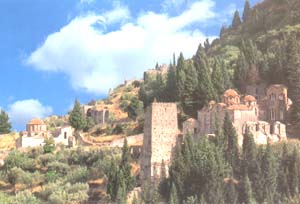 A view of Mystras |
|
| Troubled years The castle of Mystras was founded in 1249 by Geoffroi de Villehardouin on an acropolis leading up to the slopes of Mount Taygetus, 6km northwest of Ancient Sparta. Those were the difficult years following Constantinople's fall to the Franks in 1204, a disaster that led to the partition of Romania (as the Byzantine Empire was called by its inhabitants). The de Villehardouins gained rule over much of the Peloponnese, founding the principality of Achaia. To establish their governance over the unruly locals, they dotted the Peloponnese with forts. Anarchy reigned in southern Greece, as Greeks and Franks battled for dominion, establishing principalities against a background of invasions by Slavs and Albanians. The incessant ethnic strife would weaken Romania, heralding the final downfall to the Turks. De ViIlehardouin's castle was erected on a stronghold dominating the plain of Sparta. The rocky hill was known as Myzethras, a name with uncertain origins. |
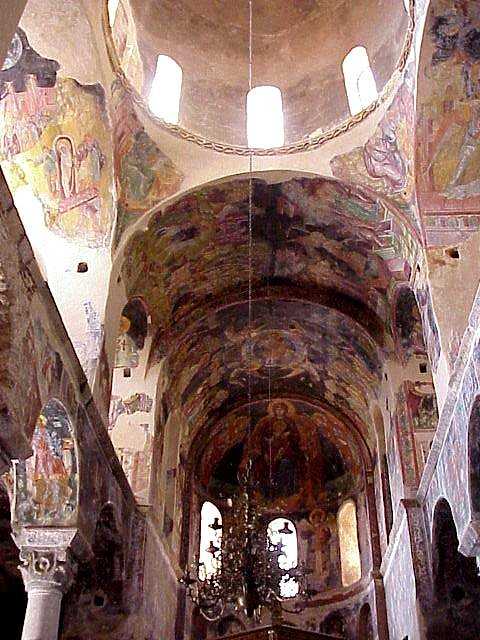 Interior View of Pantanassa |
|
One theory holds that it comes from the shape of the mountain, reminiscent of the Greek myzethra cheese. Another has it that a myzethra merchant owned the area. One way or the other, the name evolved into Mystras over the centuries. The founder was not to rule here long; defeated in battle by the Greeks in 1259, he had to hand the fort to them. Judging that the impenetrable hilltop castle provided much desired safety, the Greeks decided to build a fortified town on the slopes. Peasants fleeing the continuous strife in the plain settled inside the walls and the castle-town came into being. Mystras quickly evolved into a fine, late Byzantine town, numbering some 20,000 inhabitants. It started off as a fiefdom and ended as the capital of the Despotate of Morea, the largest Greek lordship in the Peloponnese. In 1261, Constantinople was reconquered by the Greeks, but the lands of Romania would never join again in a vast empire. The late Byzantine world was a mosaic of autonomous principalities, fighting intermittent wars with the Franks and Turks. Local rulers of the despotate were drawn from the Kantakuzeni up to 1384, then from the Palaeologi The principality was intimately connected to the Imperial throne. The Despot of Morea was the second in the line to the Constantinople throne, usually the emperor's second son. Despots transplanted the etiquette of the Imperial court and tried to imitate its splendour. The despotate was the sole Greek state in southern Greece and the base from which to launch operations against the Frankish principalities. Mystras was one of Byzantium's last spiritual and artistic centres, drawing thinkers and artists from Constantinople and the West. Bridging the Greek and Frankish worlds, the city gave birth to an art influenced by both. The last emperor of Constantinople, Constantine Palaeologos Dragases, was born here and served as despot before mounting the imperial throne. The legend has it that Constantine was crowned emperor in the Mystras cathedral of Agios Demetrios. The imperial city was taken by the Turks in 1453, where Constantine found a tragic death. Mystras fell in 1460, as did most of the Peloponnese, excluding some Venetian strongholds. The city became the capital of the sanjak of Morea and continued to prosper under the Ottomans, due to the production of silk. The new overlords did not build any mosques, but converted the churches and used the existing public buildings instead of building new ones. Thus the city conserved its form unaltered through the Ottoman rule, interrupted by brief periods of Venetian dominion. It may come as a surprise to the visitor of today's deserted ruins that Mystras was inhabited, at least partly, until the early 1920s. The Lower Town was twice burnt; by Albanian irregulars in 1770 in the aftermath of the failed revolution planned by the Russian prince Orlov, and by the Egyptians Ibrahim in their 1825 campaign against the Greek revolutionaries. After this second fire the town was emptied, survivors moving to the village of Neos Mystras in the plain and to Sparta, founded in 1830 by Otto, Greece's first sovereign, by the site of the ancient city. The Byzantine walled town was prochiimed an archaeological site and the last inhabitants removed in 1921. Only the nuns of the Pantanassa monastery remain, keeping a centuries-old tradition. In 1989, Unesco added Mystras to its World Heritage list. Hellenic identity rediscovered Ironically, it was the irreversible shrinking of the Byzantine realm and the continuous war and instability that laid the foundations for Mystras' impressive cultural, artistic and social life. Mystras' lllustrious figure was Georgios Plethon Gemistos, the most important philosopher of the mediaeval Greek world. An ardent admirer of ancient Greece and of Plato in particular, Gemistos is often credited with. preparing the Renaissance in Italy. What is less known is that he may be considered the herald of the national identity policies of the modem Greek state. So great was his admiration of Plato that he adopted the name Plethon (translated as 'of broad [knowledge]') to match that of his much admired forefather. (Plato is also an adopted name meaning 'broad'; the philosopher's real name was Aristocles ). Gemistos was born and educated in Constantinople and studied in Adrianople (Edirne), the Ottoman capital of the time, before coming to Mystras. In the capital of the despotate, the philosopber gained fame and favour and was awarded offices that ensured a decent income. Georgios lived in an era of crisis threatening the very existence of independent Greek rule. As the Byzantine empire shrank, losing its multiethnic character, the rediscovery of their identity was perplexing Greeks. Greek identity had remained in the background in theocratic Romania, the Eastern Roman Empire, where the citizens had been united under the Christian and 'Roman' tag. Yet this was no longer possible: Greeks were squeezed between enemies on all sides. Georgios, an ardent admirer of Plato's polity, urged them to abandon the rigidity of Christian dogma and to rediscover the glories of their ancient past. Christianity should be replaced by the classical memories as the dominant force of unity in the Greek world. Plethon was deeply disappointed at Orthodoxy's ascetic tendency. He stressed that what mattered was the present, not the coming world, and spoke of a Christian enslavement of the present to a distant, uncertain expectation, a recipe for an unhappy life. Deploring Orthodoxy as a passive force, he called for a religion that would nourish the political will necessary to reconstruct a well-run Greek state. Plethon was obsessed with materialising Plato's polity. He is credited with the readoption of the word Hellene as a national name: the inhabitants of 'Romania' referred to themselves as 'Romans', even though the franks still called them 'Greeks'. The name 'Roman' was in a sense perceived as a title of legitimlsation to the empire that mediaeval Greeks identified with their collective existence and destiny. Traditionally, the ancestral name 'Hellene' was associated with paganism and dismissed, although emperors and scholars sometimes used it to distinguish their people from other Balkan Orthodox. Plethon wrote in a famous letter to Manuel Palaeologos "We over whom you reign are of Hellenic race, as our tongue and ancestral education proves." His identification with the classical Greeks extended to the point of referring to God as zeus. Plethon's decision to settle in Mystras reflects the town's importance. Turks, focused on Constantinople, were not interested in southern Greece at the time. Plethon was on a quest for safe territory, free from the prevalent asceticism, where he would be able to organise the resistance to the disaster everybody sensed was imminent: the Turkish conquest. More than any other part of the Greek world, the area had preserved many of the traits of classical Greeks. "There is no other country more identified with the Hellenes than the Peloponnese, its contingent mainland and surrounding islands, that has always been inhabited by Hellenes since tile beginning of time," he wrote in his letter to Manuel. From Mystras, the philosopher planned not a reconquest of the vast empire, but the building up of a Greek state in the lands of classical Greece. For all those envisaging a Hellenic Renaissance, the Peloponnese and its capital Mystras were where it should all start. Plethon accompanied Emperor John Palaeologos and Patriarch Josef to the Council of Florence-Ferrara, convened to examine the possibility of reuniting the Eastern and Western churches. During his stay in Florence, he convinced the local ruler, Cosimo dei Medici, to found an academy for the study of Plato. The academy revived interest in Plato, forgotten in Western Europe. A professor in the academy would later be Galileo Galilei. Mystras was the refuge of Byzantium's only philosopher who dared to question Christian dogma altogether. His Laws were forbidden and ordered to be burnt by the first Patriarch of Constantinople under Ottoman rule, Gennadios Sholarios. Plethon had died in 1452, one year before his birthplace succumbed to the Turks. |
||
Walking the ruins Mystras is separated into three zones: the castle, the Upper Town of the Despots and the Lower Town; the whole is surrounded by walls. The churches are built in a unique late Byzantine style sometimes referred to as the Mystras style. The ruined forms of the homes and mansions betray a mixture of the Byzantine and Gothic styles. This is natural in a town bordering the Frankish principality of Achaia. The despots almost without exception married Frankish princesses to foster diplomatic ties, whilst visits by artists and diplomats from Western Europe were routine. All these contacts enriched the town's points of artistic reference. One should arrive at the site in the early morning to escape the heat and the crowds. Silence is necessary for indulging in the visions the natural beauty and impressive architecture bring to life. The best itinerary is to start by ascending all the way to the castle. From there the entire plain of Sparta with the Eurotas river and Mount Taygetos are visible, while the visitor can get a good idea of the town's layout. |
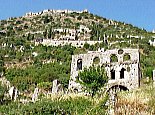 General View of Mystras 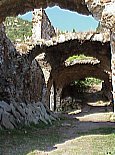 Ruined Vaults-Mystras |
|
Most visitors start by exploring the churches in the lower town first and then are too exhausted to climb in the summer heat. This is a shame, as they miss the impressive view and the rare chance at solitude. Right below the castle stand the vast forms of the palatial complexes of the Kantakuzeni (12th century) and the Palaeologi (13th century), now enveloped in scaffolding. The palaces of the despots of Morea are the most extensive ruins of Byzantine civic architecture in Europe. The complex is laid out around a vast square, the only one in town. In Byzantine times, the square was the place of all public ceremonies, whereas during Ottoman rule it was used as a market. The palaces are undergoing restoration and rebuilding, with the aim of reverting to their former glory, much battered over the centuries. |
||
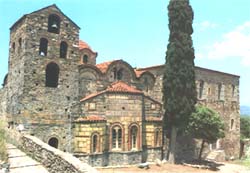 The palatial church of Agia Sophia |
Around the palaces extends the Upper Town of the nobles, with the ruins of mansions, towers and churches. The palatial church of Agia Sophia, named after the patriarchal cathedral of Constantinople, bears marked influences of the Gothic line, a tower-like campanile and interesting frescoes. Many of the surviving Upper Town mansions have a tower attached. On the way to the lower town one encounters the Pantanassa Monastery, dedicated to the Virgin 'Queen Over All'. Its five-domed church, built in 1428 on the verge of a cliff, is the best preserved monument in Mystras, an eclectic mixture of Byzantine and Gothic. Its frescoes are stunning. Nuns still dwell here and will willingly offer a glass of water to the visitor. Nearby stand the ruins of the library and the two surviving churches of the much older Vrontohi Monastery, Virgin Odegetria and Agioi Theodoroi. |
|
|
The first contains spectacular frescoes of 1312-1322, whilst those of the last date from the late 13th century. Nearby, the 14th century iconography of the stunning Virgin Peribleptos, built against the rocks, is reminiscent of that of the Chora Monastery (now Kariye Museum) of Constantinople. The church is surrounded by tiny chapels. Saint Catherine's, built in the cave, contains an unusual relief that depicts Alexander the Great carried in the heavens by two birds of prey. The Lower Town, reserved for the common people, is much more densely built. Houses are of two or three stories, since the inclination of the ground did not allow large horizontal surfaces. The streets are very narrow.Agios Demetrios, the cathedral of Mystras on the main street, is the town's oldest church. It is covered by three layers of frescoes. According to the legend, Constantine Palaeologos was crowned emperor of Constantinople on the marble plaque with the Byzantine eagle on the floor. |
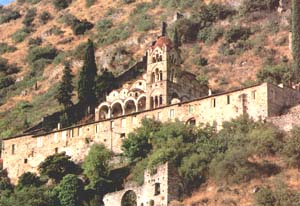 The Monastery of Pantanassa |
|
The history of Mystras is not well known. Foreign travellers up to the 19th century mentioned its palaces as the Palaces of Menelaos, confusing Byzantine Mystras with Ancient Sparta. To Greeks themselves, the names Romania and Despotate of Morea are unfamiliar. Plethon himself would have been surprised with the way the Modem Greek conscience ignored one millennium of imperial glory. |
||
|
How To Go By bus to Sparta. Mystra is 5km from the town The site is daily open to visitors from 8am to 4pm Where To Stay Hotel Menelaeionn (tel 27310-22161) Hotel Maniatis (tel 27310-22665) Hotel Lida (tel 27310-23601) Sparta Inn. (tel 27310-21021-2 & 20421-3) Hotel Vyzantion Near Mystras (tel 27310-83309) Where To Eat The Xenia restaurant in Mystras is a good option. Try either of the two taverns in the main square of the nearby scenic village of Paron |
||
(Posted originally August 2005; reformatted 2007) HCS readers can view other excellent articles by the Athens News writers and staff in many sections of our extensive, permanent archives, especially our News & Issues, Travel in Greece, Business, and Food, Recipes & Garden sections at the URL http://www.helleniccomserve.com./contents.html
All articles of Athens News appearing on HCS have been reprinted with permission. |
||
|
|
||
|
2000 © Hellenic Communication Service, L.L.C. All Rights Reserved.
http://www.HellenicComServe.com |
||

